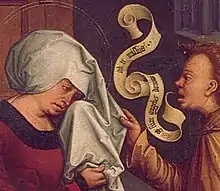phylactery
English

A phylactery (speech scroll) in a painting.
Etymology
Recorded since circa 1380, Middle English philaterie, either from Old French filatiere (12th c), or via Medieval Latin philaterium, an alteration of Late Latin phylacterium (“reliquary”), from Ancient Greek φυλακτήριον (phulaktḗrion, “safeguard, amulet”), via adjective φυλακτήριος (phulaktḗrios, “serving as a protection”), from φυλακτήρ (phulaktḗr, “watcher, guard”), itself from φυλάσσω (phulássō, “guard or ward off”), from φύλαξ (phúlax, “a guard”).[1]
Pronunciation
- (UK) IPA(key): /fɪˈlaktəɹi/
Noun
phylactery (plural phylacteries)
- (Judaism) Either of the two small leather cases, containing biblical scrolls, worn by Jewish men at morning prayer; the tefilla.
- 1526, William Tyndale, trans. Bible, Matthew XXIII:
- They sett abroade there philateris, and make large borders on there garmenttes, and love to sytt uppermooste at feastes […]
- 2003, Fred Rosner (translator), Avraham Steinberg, Encyclopedia of Jewish Medical Ethics, Volume I, Feldheim Publishers, page 787,
- Some Rabbis allow a woman or a minor who are themselves not obligated to put on phylacteries to assist a hospitalized patient to don his phylacteries if he is otherwise unable to do so.
- 2005, Edward Mack, Phylactery, Nextbible.
- "Every male, who at the age of 13 becomes a "son of the Law" (bar mitswah), must wear the phylactery and perform the accompanying ceremonial."
- 1526, William Tyndale, trans. Bible, Matthew XXIII:
- (historical) A case in which (Christian) relics were preserved.
- 2007, Sharon Farmer, 17: Low Country Ascetics and Oriental Luxury: Jacques de Vitry, Marie of Oignies, and the Treasures of Oignies, Rachel Fulton Brown, Bruce W. Holsinger (editors), History in the Comic Mode, Columbia University Press, page 209,
- After Marie was exhumed around 1226, another of her fingers was placed in a phylactery that was created by Hugh of Oignies and remained at Oignies until 1817 (see fig. 17.1).
- 2007, Sharon Farmer, 17: Low Country Ascetics and Oriental Luxury: Jacques de Vitry, Marie of Oignies, and the Treasures of Oignies, Rachel Fulton Brown, Bruce W. Holsinger (editors), History in the Comic Mode, Columbia University Press, page 209,
- Any small object worn for its magical or supernatural power; an amulet or charm.
- 2006, Don Skemer, Binding Words: Textual Amulets in the Middle Ages. Pennsylvania State University Press, 2006, p. 136n:
- According to the decreta issued by the archbishop of Utrecht in 1372-75, the word phylactery pertained either to amulets on separate sheets or to entire books.
- 2006, Don Skemer, Binding Words: Textual Amulets in the Middle Ages. Pennsylvania State University Press, 2006, p. 136n:
- (fantasy, mythology, role-playing games) An enspelled object used (by such as a lich) to contain and protect the owner's soul.
- 2007, Tim Waggoner, Forge of the Mind Slayers, Wizards of the Coast, page 21,
- "Heh. No. You're right about that. Often an object that was important to a lich in life serves as the phylactery, but it could be anything," Diran said.
- 2011, J. L. Connew, Origins of the Geomancer, Xlibris, page 112,
- 'So,' says Calli impatiently, holding her head proudly, 'let's destroy the phylactery and let the lich rot in peace and then take the artefacts.'
- 'It's not as simple as that,' says Joachim. 'The phylactery is the mask.'
- An unnerving silence fills the room. The only way to destroy a lich permanently is to destroy the phylactery it uses to house its soul.
- 2017, Jason Paul McCartan, Through Dungeons Deeper: A Survival Guide For Dungeoneers: As Written by a Survivor, InfiniBadger Press, page 121,
- Destroying the lich without destroying the phylactery first just allows the lich to regenerate its body over time (or steal someone else's) and it really pisses them off. With the intense connection a lich has with its phylactery if it gets destroyed the lich will know instantly.
- 2007, Tim Waggoner, Forge of the Mind Slayers, Wizards of the Coast, page 21,
- (art, historical) A speech scroll, an illustrative device depicting speech, song or other sound as if written on a scroll.
- 2011, Robert S. Petersen, Comics, Manga, and Graphic Novels: A History of Graphic Narratives, ABC-CLIO (Praeger), page 28,
- Just as phylacteries became more commonplace in prints in the 17th century, there was a growing aversion for the use of phylacteries in paintings.
- 2013, Ana M. Gómez-Bravo, Textual Agency: Writing Culture and Social Networks in Fifteenth-Century Spain, University of Toronto Press, page 80,
- That the inscribed rolls (also referred to as phylacteries, ribbons, banderoles, or scrolls) depicted in, for example, manuscript illuminations are signs of a residual orality that would work much like a speech balloon is an interpretation challenged not only by codicolgical and diplomatic evidence, however scant, but further by the use of hands in the iconography of the period.
- 2015, Roberto Bartual Moreno, The Origins of Graphic Narrative in Popular Culture, Esther Claudio, Julio Cañero (editors), On the Edge of the Panel: Essays on Comics Criticism, Cambridge Scholars Publishing, page 38,
- On the other hand, the pseudo-dialogues inside the phylacteries introduce an ironic tone in narrative strips like Barlow's, but they are not a means of dramatization; it is as if the characters, instead of talking to each other, were talking to the reader in order to state their intentions, make witty comments, or explain the situation.
- 2011, Robert S. Petersen, Comics, Manga, and Graphic Novels: A History of Graphic Narratives, ABC-CLIO (Praeger), page 28,
Translations
leather case containing biblical scrolls, worn by Jewish men; the tefilla
|
|
case for a relic
small object worn for its magical power; amulet or charm
object enspelled so as to contain and protect a soul
speech scroll
See also
- klaf
- mezuzah
References
- Archbishop of Utrecht, Arnold II van Hoorn, 1372-1375.
This article is issued from Wiktionary. The text is licensed under Creative Commons - Attribution - Sharealike. Additional terms may apply for the media files.